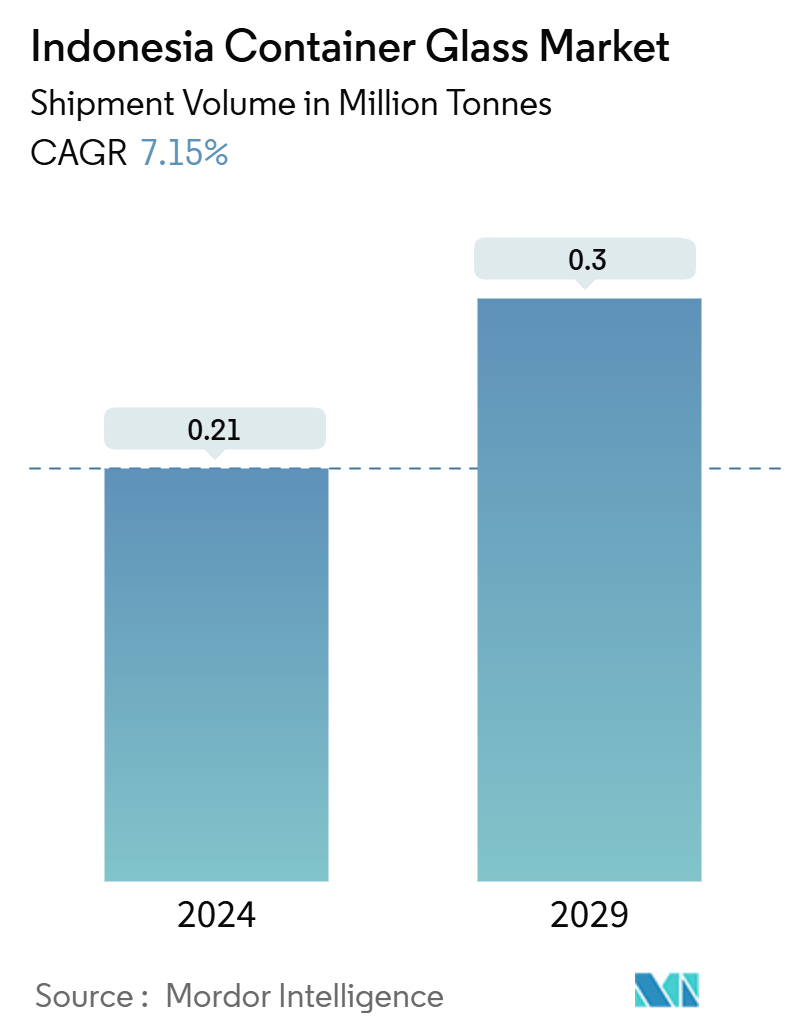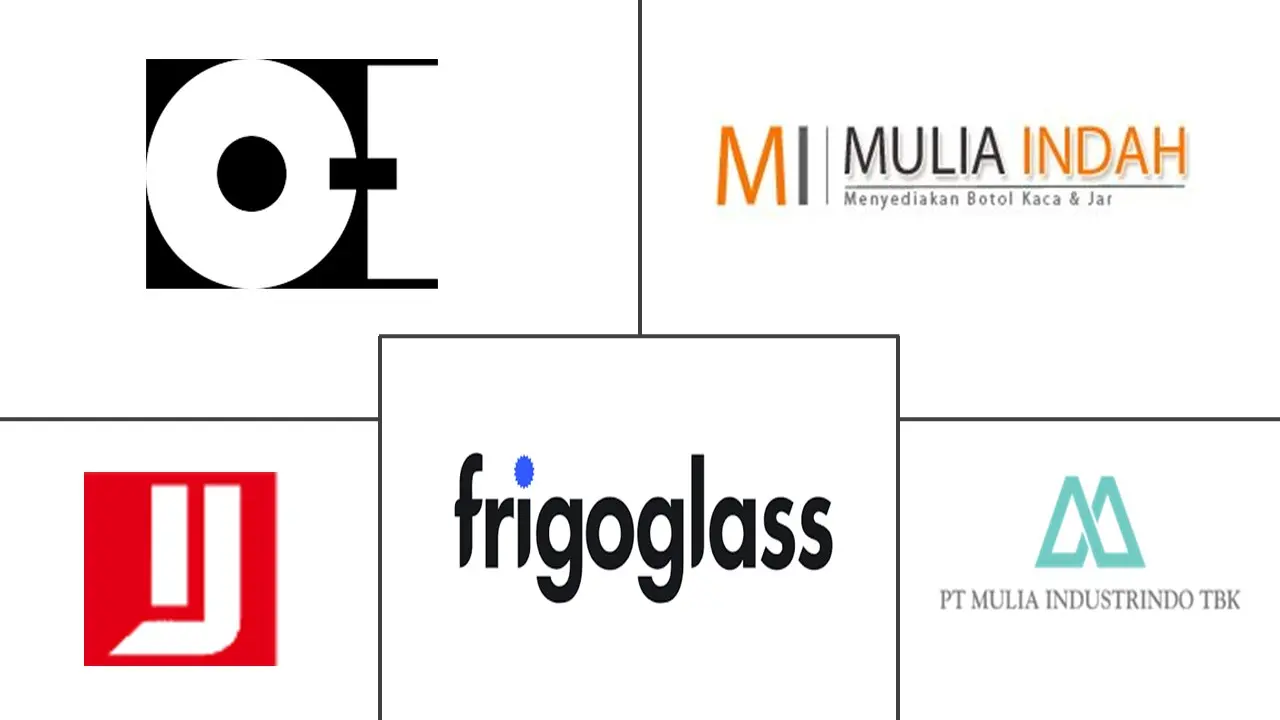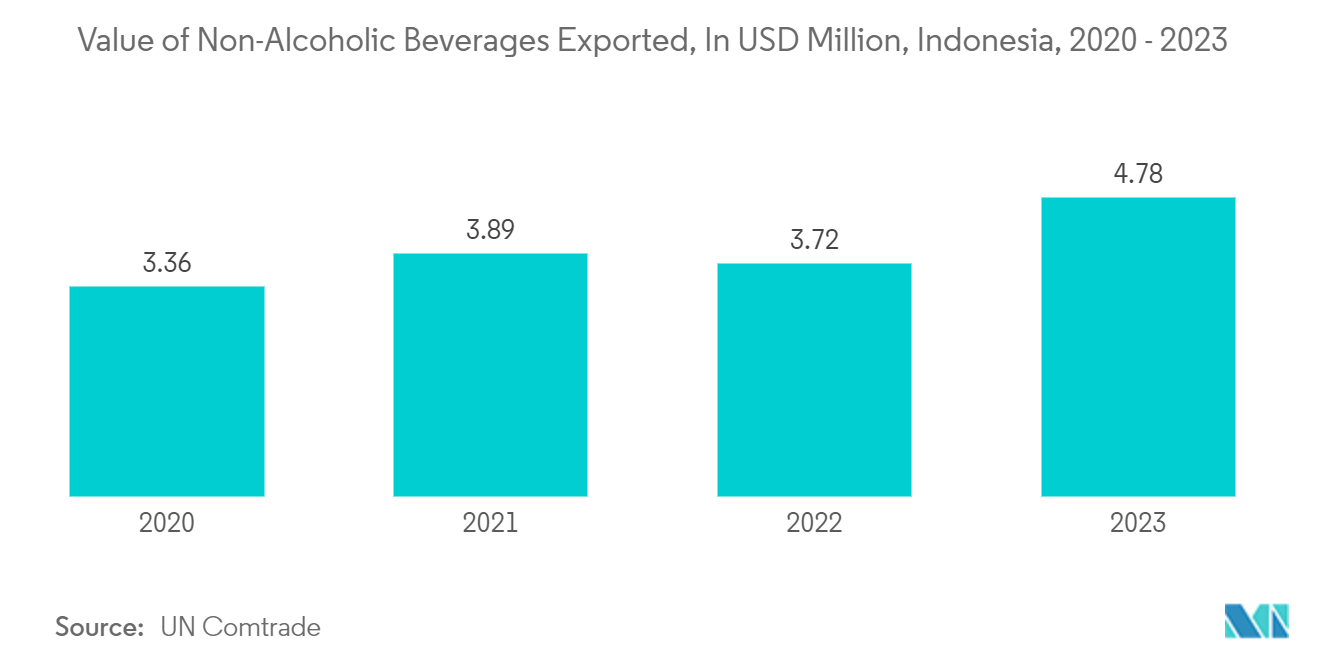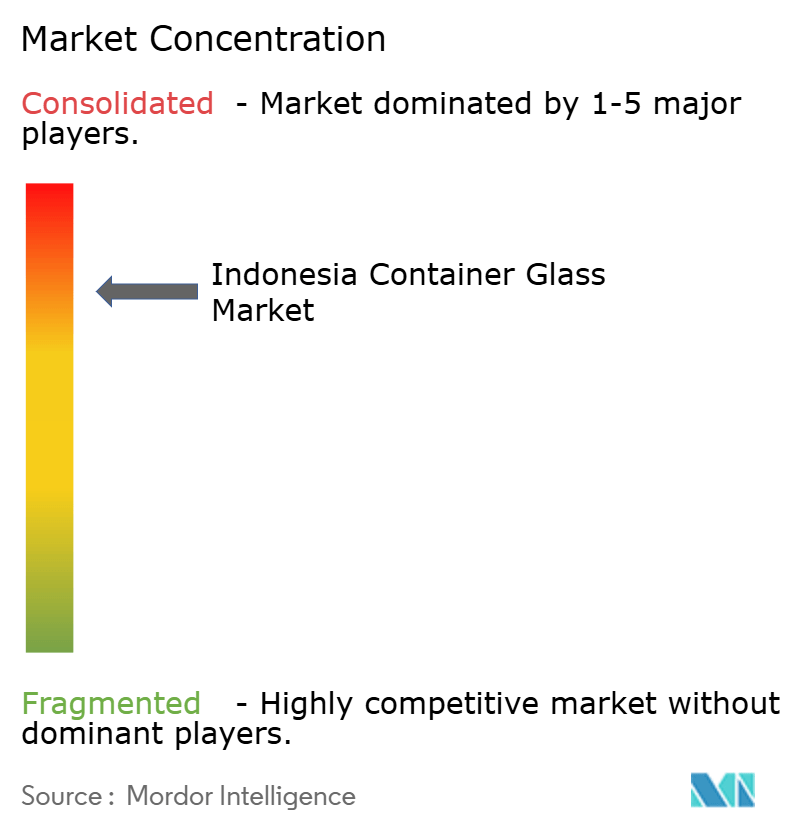Indonesia Container Glass Market Size

| Study Period | 2019 - 2029 |
| Base Year For Estimation | 2023 |
| Market Volume (2024) | 0.21 Million tonnes |
| Market Volume (2029) | 0.3 Million tonnes |
| CAGR (2024 - 2029) | 7.15 % |
| Market Concentration | High |
Major Players
*Disclaimer: Major Players sorted in no particular order |
Indonesia Container Glass Market Analysis
The Indonesia Container Glass Market size in terms of shipment volume is expected to grow from 0.21 Million tonnes in 2024 to 0.3 Million tonnes by 2029, at a CAGR of 7.15% during the forecast period (2024-2029).
Key drivers in the container glass market include the expanding end-user industries such as food and beverage, the rising preference for eco-friendly glass packaging, shifting consumer demand for sustainable products, and innovations in packaging designs.
- Steady economic growth in Indonesia has spurred demand across sectors like consumer goods, bolstering the glass manufacturing sector. With a growing urban population and proactive government infrastructure initiatives, the demand for container glass has surged.
- Rising disposable incomes and evolving lifestyles have heightened the demand for household glass products, including bottles and containers. According to the Cabinet Secretariat of the Republic of Indonesia, household consumption and non-profit institutions serving households grew by 4.9% and 24.3% year-on-year. The rise in household spending and consumption will further drive the demand for the container glass market.
- Indonesia's pharmaceutical industry is on an upward trajectory, with the glass sector poised to capture a larger share of pharmaceutical packaging. This burgeoning market is drawing the attention of foreign investors, especially with the rise of digital healthcare in the country. According to a study by Permata Bank in Indonesia, in 2023, provinces in Java dominated Indonesia's pharmaceutical and traditional medicine industry, accounting for approximately 83% of the total market.
- As reported by the United Nations Environment Programme, Indonesia, home to approximately 250 million people, ranks as the world's fourth most populous nation and the second-largest contributor to plastic pollution. The country generates a staggering 3.2 million tonnes of unmanaged plastic waste annually. The impact of plastic waste in the country would further drive the demand for container glass packaging over the forecast period.
- Glass manufacturing relies on critical raw materials, including silica sand, soda ash, and limestone. However, challenges arise in consistently and cost-effectively sourcing these materials, particularly when sources are limited or geopolitical factors come into play. Due to the elevated temperatures needed to melt raw materials, glass manufacturing is notably energy-intensive.
Indonesia Container Glass Market Trends
Cosmetics Industry to Witness Growth
- Indonesia's cosmetics market is competitive, and glass is one of the primary materials used in the cosmetics industry. Establishing a robust brand through effective promotion is essential to making a significant entry. Indonesians are increasingly attentive to their personal image and fashion choices. Across all categories—hair care, skincare, makeup, fragrance, and hygiene—75% of Indonesian women favor beauty products crafted from natural ingredients.
- In Indonesia, personal care and cosmetics reach consumers through various channels: specialty stores, drug stores, department stores, supermarkets, direct marketing (MLM), skin care clinics, and beauty salons. According to the World Bank, Indonesia's economy is projected to maintain its resilience through 2026, achieving an average annual GDP growth rate of 5.1%. Factors such as a burgeoning young generation, increasing disposable incomes, an expanding middle class, and a growing economy present beauty firms with abundant opportunities, both on domestic and international fronts.
- Skincare demand is on the rise. At the recent East Ventures Summit 2024, the management of BASE, a beauty and wellness startup, highlighted the sector's significant growth potential. These trends mirror a broader shift among Indonesian consumers, who increasingly prioritize skincare products that deliver real health benefits. A prime example is the surging demand for UV protection, driven by widespread awareness of sunscreen's importance. Local and global brands entering the Indonesian market have seized this opportunity to meet the escalating demand.
- Cosmobeauté Indonesia, in October 2023, highlights the nation's impressive economic growth over recent decades. As technology and beauty trends evolve, numerous beauty companies actively engage in the supply chain to meet the rising demand for cosmetic products. The industry's rapid expansion sees manufacturers increasingly reliant on technological advancements and timely market insights.
- Further, international beauty brands are gaining traction in the country. For instance, according to the Korean Foundation for International Cultural Exchange (KOFICE), Korean beauty products in Indonesia were popular by 61.9% in 2023, and their popularity rose from 31.2% in 2021. For cosmetic companies, efficient and effective supply chain management is crucial to gaining a competitive edge. In response to these dynamics, Cosmobeauté Indonesia is broadening its focus within the supply chain, encompassing the packaging, OEM/ODM, machinery and equipment, and ingredient and formulation sectors. All the above factors drive the demand for the container glass market in the cosmetic industry.

Beverage Sector is Anticipated to Drive the Market Growth
- Beverages, ranging from juices and alcoholic drinks to meal replacement shakes, are increasingly turning to the container glass market. Factors like pressure and contaminants can influence beverage quality, and even slight changes can alter a beverage's composition. To combat this, companies opt for glass packaging.
- One factor driving the beverage industry in the country is rising tourism. According to a study by the World Travel and Tourism Council in June 2024, Indonesia's tourism sector rebounded robustly, surging by 29.5%, accounting for 4.8% of the nation's economic output in 2023. Projections indicate that by 2034, this sector's contribution to Indonesia's GDP might increase to 5.3% of the economy. Tourists opt for a variety of beverages that include both non-alcoholic and alcoholic, raising the demand for container glasses in the country.
- The government is also focused on expanding the beverage sector in the country through initiatives. The Indonesian Ministry of Industry is championing Industry 4.0 across the beverage sector and beyond. By July 2023, the government had already trained 200 businesses. The aim is to equip beverage sector owners with competency certificates by the end of the year, in line with the "Making Indonesia 4.0" roadmap.
- Further, the country is witnessing demand for container glass products owing to demand from various beverages. According to International Trad Center, the imports of glass packaging products in 2020 was valued at USD 80.24 million and it has increased to USD 93.27 million in 2023.
- Addtioanlly, according to UN Comtrade, the value of non-alcoholic beverages exported from the country in 2020 was USD 3.36 million and it has increased to USD 4.78 million in 2023. Therefore, rise in the trade indicate the demand for container glass products in the country.

Indonesia Container Glass Industry Overview
Growing consumer preference for eco-friendly packaging, alongside the continuous expansion of the glass container market, is propelling its steady growth. The surging demand for beverages, organic products, and premium packaging has also intensified the market's appetite for glass containers.
The Indonesia container glass market is consolidated. Key players operating in the country include global and domestic players such as Owens-illnois, Inc., FrigoGlass, PT Indoglas Jaya, Mulia Indah Packaging, and others. These companies are pursuing strategies such as new product development, expansion, and mergers and acquisitions to enhance product functionality and broaden their geographic presence in the country.
Indonesia Container Glass Market Leaders
-
Owens-Illnois Inc.
-
FrigoGlass
-
PT Indoglas Jaya
-
PT Mulia Industrindo Tbk
-
Mulia Indah Packaging
*Disclaimer: Major Players sorted in no particular order

Indonesia Container Glass Market News
- October 2024: According to data published by Minime Insights to enhance circularity, the Coca-Cola Co has reintroduced its Original Glass bottle in Indonesia. Glass packaging champions circularity, allowing glass to be recycled endlessly without compromising quality, thus fostering a closed-loop system. They are primarily targeting food outlets in Jakarta, the beverage giant is offering drinks in a 200ml glass bottle priced at IDR 3,000 (USD 0.19).
- June 2024: Judydoll, a prominent makeup brand from Shanghai, officially debuted in Indonesia during the Jakarta x Beauty (JxB) 2024 event. The brand showcased over 60 SKUs across various makeup categories, featuring its trending products like Iron Mascara and an extensive range of over 20 blush shades. Judydoll's offerings have catapulted it to global fame, especially on social media platforms. Judydoll stands out as one of the pioneering brands to launch in Indonesia.
Indonesia Container Glass Market Report - Table of Contents
1. INTRODUCTION
1.1 Study Assumptions and Market Definition
1.2 Scope of the Study
2. RESEARCH METHODOLOGY
3. EXECUTIVE SUMMARY
4. MARKET INSIGHTS
4.1 Market Overview
4.2 PESTEL ANALYSIS - Container Glass Industry in Indonesia
4.3 Industry Standards and Regulations for Container Glass for Packaging
4.4 Raw Material Analysis & Material Considerations for Packaging
4.5 Sustainability Trends for Packaging
5. MARKET DYNAMICS
5.1 Market Drivers
5.1.1 Change in Consumer Preferences and Demand for Eco-friendly Packaging
5.1.2 Surging Demand for Glass in Beverage and Pharmaceutical Sectors
5.2 Market Restraint
5.2.1 Rising Production Costs Amidst the Emergence of Alternative Materials
5.3 Analysis of the Current Positioning of Indonesia in the Asia-Pacific Container Glass Market
5.4 Trade Scenario - Analysis of the Historical and Current Export-Import Paradigm for the Container Glass Industry in Indonesia
6. MARKET SEGMENTATION
6.1 End-user Industry
6.1.1 Beverage
6.1.1.1 Alcoholic Beverages
6.1.1.1.1 Wines and Spirits
6.1.1.1.2 Beer and Cider
6.1.1.1.3 Other Alcoholic Beverages
6.1.1.2 Non-Alcoholic Beverages
6.1.1.2.1 Carbonated Drinks
6.1.1.2.2 Juices
6.1.1.2.3 Water
6.1.1.2.4 Dairy-Based
6.1.1.2.5 Flavored Drinks
6.1.1.2.6 Other Non-Alcoholic Beverages
6.1.2 Food
6.1.3 Cosmetics
6.1.4 Pharmaceuticals
6.1.5 Other End user verticals
7. COMPETITIVE LANDSCAPE
7.1 Company Profiles
7.1.1 Owens-Illnois Inc.
7.1.2 Sukijo Bottle Packaging
7.1.3 Mulia Indah Packaging
7.1.4 PT Indoglas Jaya
7.1.5 PT Mulia Industrindo Tbk
7.1.6 FrigoGlass
8. SUPPLEMENTARY COVERAGE - ANALYSIS OF MAJOR FURNACE SUPPLIERS TO CONTAINER GLASS PLANTS IN INDONESIA
9. FUTURE OUTLOOK OF THE MARKET
Indonesia Container Glass Industry Segmentation
Glass Containers refer to clean bottles and jars made from glass. The scope excludes windows and other non-container glass products. Container glass is used in the alcoholic and non-alcoholic beverage industries due to its ability to maintain chemical inertness, sterility, and non-permeability. Glass packaging is valued for its unique properties, including its transparency, inertness, and ability to preserve the quality and integrity of its contents.
Indonesia Container Glass Market is Segmented by End-User Industry ((Beverages (Alcoholic Beverages (Wines and Spirits, Beer and Cider, and Other Alcoholic Beverages) and Non-Alcoholic Beverages (Carbonated Drinks, Juices, Water, Dairy-Based, Flavored Drinks, Other Non-Alcoholic Beverages)), Food, Cosmetics, Pharmaceuticals, and Other End-User Industries). The Market Sizes and Forecasts are Provided in Terms of Volume (Tonnes) for all the Above Segments.
| End-user Industry | |||||||||||||||
| |||||||||||||||
| Food | |||||||||||||||
| Cosmetics | |||||||||||||||
| Pharmaceuticals | |||||||||||||||
| Other End user verticals |
Indonesia Container Glass Market Research FAQs
How big is the Indonesia Container Glass Market?
The Indonesia Container Glass Market size is expected to reach 0.21 million tonnes in 2024 and grow at a CAGR of 7.15% to reach 0.3 million tonnes by 2029.
What is the current Indonesia Container Glass Market size?
In 2024, the Indonesia Container Glass Market size is expected to reach 0.21 million tonnes.
Who are the key players in Indonesia Container Glass Market?
Owens-Illnois Inc., FrigoGlass, PT Indoglas Jaya, PT Mulia Industrindo Tbk and Mulia Indah Packaging are the major companies operating in the Indonesia Container Glass Market.
What years does this Indonesia Container Glass Market cover, and what was the market size in 2023?
In 2023, the Indonesia Container Glass Market size was estimated at 0.19 million tonnes. The report covers the Indonesia Container Glass Market historical market size for years: 2019, 2020, 2021, 2022 and 2023. The report also forecasts the Indonesia Container Glass Market size for years: 2024, 2025, 2026, 2027, 2028 and 2029.
Indonesia Container Glass Industry Report
Statistics for the 2024 Indonesia Container Glass market share, size and revenue growth rate, created by ����vlog��ý™ Industry Reports. Indonesia Container Glass analysis includes a market forecast outlook for 2024 to 2029 and historical overview. Get a sample of this industry analysis as a free report PDF download.



